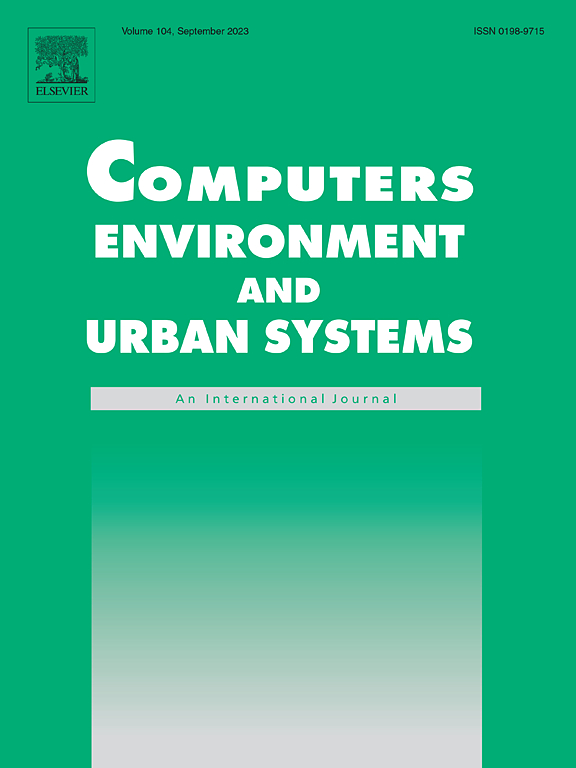Future scenarios for urban agriculture and food security in sub-Saharan Africa: Modelling the urban land-food system in an agent-based approach
IF 8.3
1区 地球科学
Q1 ENVIRONMENTAL STUDIES
Computers Environment and Urban Systems
Pub Date : 2025-02-18
DOI:10.1016/j.compenvurbsys.2025.102258
引用次数: 0
Abstract
Food systems in sub-Saharan African cities are increasingly pressured by rapid urban sprawl and socio-economic changes. While land conversion from cropland to built-up area is limiting the opportunity for urban agriculture, food demand is rising because of population growth and changing diets. Meanwhile, socio-economic segregation – often associated with urbanization - can hinder access to food. For the case study of Kampala (Uganda), we spatiotemporally model the land-food system using an agent-based approach. Based on 747 household surveys, we recalibrated the Agent-based model of Social Segregation and Urban Expansion (ASSURE) by Vermeiren et al. (2016) and included food system dynamics to assess future trajectories (2020–2040) of Kampala's dependency on urban agriculture. While food that is both produced and consumed within the city is often considered the most resilient food source in times of crisis, we show that it is particularly this source that is threatened. Overall, about 10 % of the urban and peri-urban agricultural land in Kampala is projected to disappear by 2040. This may lead to decreased levels of food security and dietary diversity, particularly for households that strongly rely on urban agriculture. Information on the links between urban growth and local food provision is essential for planners who aim to develop strategies for more secure, just and sustainable African urban food systems.
撒哈拉以南非洲城市农业和粮食安全的未来情景:以主体为基础的方法模拟城市土地-粮食系统
撒哈拉以南非洲城市的粮食系统正日益受到城市快速扩张和社会经济变化的压力。虽然从农田到建成区的土地转换限制了城市农业的机会,但由于人口增长和饮食变化,粮食需求正在上升。与此同时,社会经济隔离——通常与城市化有关——可能阻碍获得粮食。对于坎帕拉(乌干达)的案例研究,我们使用基于代理的方法对土地-粮食系统进行时空建模。基于747个家庭调查,我们重新校准了Vermeiren等人(2016)的基于主体的社会隔离和城市扩张模型(ASSURE),并纳入了粮食系统动力学来评估坎帕拉对城市农业依赖的未来轨迹(2020-2040)。虽然在危机时期,城市生产和消费的食物通常被认为是最具弹性的食物来源,但我们表明,受到威胁的尤其是这一来源。总体而言,预计到2040年,坎帕拉约10%的城市和城郊农业用地将消失。这可能导致粮食安全和饮食多样性水平下降,对高度依赖都市农业的家庭来说尤其如此。关于城市增长与当地粮食供应之间联系的信息对于旨在制定更安全、公正和可持续的非洲城市粮食系统战略的规划者至关重要。
本文章由计算机程序翻译,如有差异,请以英文原文为准。
求助全文
约1分钟内获得全文
求助全文
来源期刊

Computers Environment and Urban Systems
Multiple-
CiteScore
13.30
自引率
7.40%
发文量
111
审稿时长
32 days
期刊介绍:
Computers, Environment and Urban Systemsis an interdisciplinary journal publishing cutting-edge and innovative computer-based research on environmental and urban systems, that privileges the geospatial perspective. The journal welcomes original high quality scholarship of a theoretical, applied or technological nature, and provides a stimulating presentation of perspectives, research developments, overviews of important new technologies and uses of major computational, information-based, and visualization innovations. Applied and theoretical contributions demonstrate the scope of computer-based analysis fostering a better understanding of environmental and urban systems, their spatial scope and their dynamics.
 求助内容:
求助内容: 应助结果提醒方式:
应助结果提醒方式:


